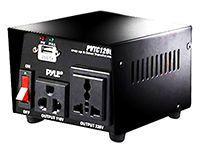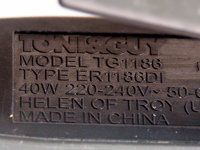The Cayman Islands power converters - Do you need a power converter in The Cayman Islands?
What does a power converter for The Cayman Islands do?
A power converter for The Cayman Islands will enable travellers to use their 220, 230 or 240 volt electrical appliance with a 120 volt Cayman Islands power outlet.
Also known as: electrical converter, electrical transformer, voltage converter, power transformer or voltage transformer.
What is the difference between a power converter and a plug adapter for The Cayman Islands?
A small, cheap and lightweight power adapter (or plug adapter) changes the shape of the plug on your device to slot into a power outlet found in The Cayman Islands, but an expensive and bulkier power converter will transform the voltage of 120 volts from a Cayman Islands power outlet to work with a non-120 volt device. [3] [AD]
Do I need a power converter for The Cayman Islands?
When travelling to The Cayman Islands from another country check your device can be charged using a 120 volt power supply.
- You need a step up power converter if you are travelling to The Cayman Islands from a country that uses 220-240 volts and your appliance or device won't support 120 volts. See the list of world power outlets page to find out which voltage your country uses.
- You shouldn't need a power converter if you are already using either a 120 volt device or one that supports dual voltage.
- Normally electrical devices which come from a different country which use a higher voltage (such as 230 volts) and used with 120 volts can take longer to charge or won't turn on. If your device charges slowly or does not power up when travelling to The Cayman Islands from a different region check that it can be used with a 120 volt power outlet otherwise you will need a step up power converter.
- You won't need a power converter if you are attempting to charge a smaller electrical device such as a laptop as these are normally dual voltage and designed for international use, however you should always check the device for dual voltage support prior to your journey.
- For powering high wattage appliances or generate heat (for example hair straighteners and clothes irons) then you will need to use a much larger higher wattage heavy duty power converter.
- It should be more cost effective to purchase a smaller robust dual voltage travel appliance than paying for a heavier high wattage power converter to The Cayman Islands just to use your existing domestic appliance.
- Read our comprehensive travel guides on using clothes irons, curling wands, hair straighteners and blow dryers in The Cayman Islands which includes recommendations for affordable dual voltage alternatives. [4] [5] [AD]
What converter do I need for The Cayman Islands?
If you need to use any 220, 230 or 240 volt appliance in The Cayman Islands you will need a step up power converter. [4] [AD]
What voltage is used in The Cayman Islands?
The Cayman Islands uses 120 volts in their normal power outlets. [2]
How to convert 120 volts to 220 volts
- Use a step up power converter to allow you to use 220, 230 and 240 volt appliances with a 120 volt Cayman Islands power outlet.
- If the power converter doesn't include the correct shaped plug then it will also be necessary to plug in the power cord from the power converter into a power adapter for The Cayman Islands before plugging that into a Cayman Islands power outlet.
- Some power converters include the ability to perform both step up and step down voltage conversions, therefore it may be necessary to manually switch the converter to output the voltage from 220-240v.
- Plug your appliance into the converter and turn the power on, your 220-240 volt appliance can now be used with a 120 volt Cayman Islands power outlet. [4] [AD]

Voltage converter
What is the difference between a power converter and a power transformer?
Converters and transformers are both used to change one voltage to another, but this ambiguity can cause confusion as their purposes are different:
- Power converters are designed for simple electrical appliances which typically generate heat or use motors such as clothes irons, shavers or hair dryers. Transformers are designed for more complex electronic items such as televisions or games consoles.
- Buying a power converter is cheaper than buying a power transformer.
- Power transformers are larger and heavier making them more suited for permanent residential use; for example an expat wishing to use an imported television would need to use a transformer for this purpose.
- Power converters are more suitable for travellers wishing to bring domestic appliances abroad such as hair dryers or flat irons. However, it is more practical and cost effective to purchase a dual voltage appliance designed for travel rather than a heavier power converter.
- Power converters are suitable for 2 pin ungrounded appliances, it could be harder to find a converter if you want to use a grounded 3 pin appliance.
- Transformers can be used constantly however it is recommended that converters are used for no longer than a couple of hours at a time.
- Shops may sell transformers under the name of converters, for the purposes this guide we will be referring to both converters and transformers as converters.

Single voltage hair straighteners
What voltage is my device?
The best method to see if your device is dual or single voltage is to look for numbers printed on the existing charger or on the unit itself, typically near to where the power cord plugs into. The location might depend on the make or model of your unit and should also be written in the instruction manual.
- Single voltage devices might say a specific number - such as 220V.
- Single voltage devices could also have a small voltage range (around 20 volts) with a dash to accomodate small voltage fluctuations - such as 100-120V.
- Dual voltage devices will typically say a larger range separated with a slash - such as 110/240V.
External links
We endeavour to ensure that links on this page are periodically checked and correct for suitability. This website may receive commissions for purchases made through links on this page. As an Amazon Associate WikiConnections earn from qualifying purchases. For more details please read the disclaimers page.
- Wikipedia - Cayman Islands wikipedia page.
- iec.ch - International Electrotechnical Commission World Plugs
- Power converter - Heavy-duty power converters are designed to convert voltage levels between different electrical standards, shifting between 110V/120V and 220V/240V with both 50Hz and 60Hz, often incorporating safety features such as fuse protection and circuit breakers..
- Step up power converter - Step-up power converters are engineered to convert lower voltage outlets of 100V/120V to higher voltages of 220V/240V, enabling the use of appliances designed for higher-voltage environments in lower voltage countries..
- Heavy duty power converter - Heavy-duty power converters robust voltage transformation capabilities for designed for high-wattage devices, making them best suited for appliances like kettles and hair dryers that consume a significant amounts of power..